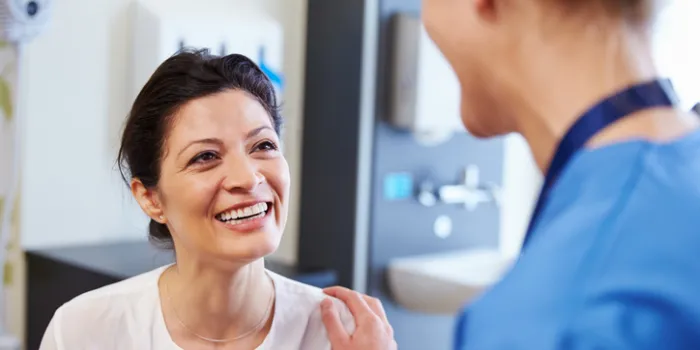Like many young women with a bleeding disorder, Carey Palmer, of Atlanta, entered puberty with worries most girls her age don’t face. Diagnosed with von Willebrand disease (VWD) at age 9, Palmer knew that one of the common symptoms of VWD is heavy menstrual bleeding. And following her first period at age 12, she struggled to find optimal treatment.

Until last year, Palmer saw a gynecologist unaffiliated with her hemophilia treatment center (HTC) to help manage her bleeding, a process that proved frustrating. “It was very hard keeping both offices on the same page when they were not communicating with each other,” says Palmer, now 18. A year ago, she transferred her gynecological care to the Comprehensive Bleeding Disorders Center at Emory University and Children’s Healthcare of Atlanta (CHOA), an HTC that includes specialized services for women and adolescent girls with blood disorders. (Palmer had been diagnosed with VWD at CHOA and had previously received her hematological—but not her gynecological—care there.)
For women and girls like Palmer, comprehensive clinic models that more seamlessly combine women’s reproductive and hematologic healthcare are a welcome development. Across the country these clinics vary in terms of services offered, but many have an array of additional staff specially equipped to manage women’s bleeding disorders, including gynecologists or adolescent medicine specialists, geneticists, social workers, psychiatrists or psychologists, and nurse practitioners.
“When you put that all together, this clinic model does a really nice job of trying to address all the emerging needs and issues that young women and girls have,” says Robert Sidonio Jr., MD, MSc, a pediatric hematologist/oncologist and clinical director of the hemostasis and thrombosis program at the Aflac Cancer and Blood Disorders Center of Children’s Healthcare of Atlanta. Sidonio is a leading proponent of improved care for women with bleeding disorders.
In this model, when girls have their first period (and leading up to it), they have access to specially trained gynecologists or adolescent medicine specialists. Some centers treat patients as young as 10 who have bleeding disorders.
Emotional side effects
Staffed with mental health professionals, clinics with designated services for female patients don’t just look after adolescent girls’ physical health. The emotional side effects of being a woman with a bleeding disorder are addressed as well. At the Young Women’s Hematology Clinic in Dublin, Ohio, for instance, patients are first seen by an all-female team to put them at ease.
“Our doctors are able to communicate with each other within minutes to discuss their treatment plan,” says Linda Casto, LISW-S, program coordinator and social worker for the hemostasis and thrombosis team at Nationwide Children’s Hospital in Columbus, Ohio, which staffs and oversees the nearby Dublin clinic. Like most specialized women’s clinics within HTCs, the Young Women’s Clinic operates on a limited schedule, seeing patients two days a month. (The CHOA clinic sees women and girls as part of its new comprehensive care model one day a month, and female patients can be seen by the hematologist without the gynecologist weekly.) The nonprofit Foundation for Women & Girls with Blood Disorders maintains a national online directory of HTCs that offer dedicated services for women and girls (see “Finding Specialized Care,” below).
During their periods, it’s not uncommon for women or girls with bleeding disorders to change pads or tampons every hour or two. This can impact school, work or social activities, and be a source of embarrassment and shame.
Seemingly simple situations, such as asking a teacher to go to the bathroom to change sanitary products, particularly if it’s a male teacher, can be emotionally difficult for a young woman, says Casto, who helps girls come up with strategies for managing these kinds of circumstances. “It’s really about encouraging them to communicate on a difficult topic to school administrators and teachers, helping them to be assertive for their own health and well-being,” she says.
Another frequent emotional hurdle many girls must face is starting birth control pills as a hormonal intervention in their preteen or teen years. Such hormonal therapy is often prescribed to young women to reduce heavy menstrual bleeding. And for girls who aren’t yet sexually active, being prescribed birth control pills to manage a bleeding disorder can be confusing and distressing.
“These patients require in-depth counseling at a young age about hormonal management of their bleeding disorders, since hormones are more often used for birth control in women and there can be a social stigma attached to taking them so young,” says Shaveta Malik, MD, an obstetrician/gynecologist and co-director of the S.H.E. Clinic (Specialized Hematology Experts), a specialty clinic that diagnoses and treats women and girls as part of the Hemophilia Center of Western New York, an HTC in Buffalo, New York.
In addition, every woman and girl is different, and thus there is no one-size-fits-all treatment. In Carey Palmer’s case, for example, her first gynecologist put her on birth control pills to help manage her heavy menstrual bleeding. They didn’t help, Palmer says, and worse, they affected her emotional well-being. Her new gynecologist at the CHOA HTC clinic switched her to an intrauterine device (IUD) instead. “Being at a comprehensive clinic helped me understand the purpose of the birth control at such a young age with my bleeding disorder,” says Palmer. “Switching to the IUD was a fantastic decision because it stopped my period.”
Women with heavy menstrual bleeding may also experience low iron levels, which can mimic depressive symptoms. Casto says at women’s bleeding disorders clinics, specially trained staff has more experience with such issues and thus can properly evaluate the full picture of a woman’s health.
Safeguarding reproductive health
In women with bleeding disorders, proper management of menstruation and gynecological care isn’t just about tackling discomfort and inconvenience. Left undiagnosed or untreated, a bleeding disorder can put a young woman’s reproductive health at risk. And when a woman considers having children, educating her about what to expect is key. Staff at specialized clinics cover potential complications during pregnancy, labor and delivery, taking into account a woman’s particular bleeding disorder symptoms and her overall health.
There is a lot to consider. For instance, women who want to get pregnant must stop the hormonal therapy that for many eases their heavy menstrual bleeding. But stopping therapy can cause worsening periods, anemia, fainting and visits to the emergency room for acute heavy bleeding, says Malik. In some patients with a severe bleeding disorder, discontinuation of birth control isn’t always possible, even if they want to get pregnant. “These patients often need multiple medications to control their bleeding symptoms, and not being on birth control can potentially lead to complications resulting from heavy bleeding,” says Malik. Women need such information to make informed decisions. “The conversations about sexual and reproductive health in patients with bleeding disorders are complex and often require shared decision-making between the patient and a team of healthcare professionals from different areas of medicine,” says Malik.
Advancing research
In terms of bettering the overall healthcare picture for women with bleeding disorders, the inclusion of gynecologists in comprehensive clinics brings a much-needed understanding of hormone therapy that hematologists lack, says Emory’s Sidonio. “We didn’t have these resources before, and it was really difficult to see these women and girls bounce back and forth from emergency room to emergency room and bouncing around to different gynecological providers,” he says.
Dedicated women’s clinics are also helping to advance bleeding disorders treatment and management in women and girls, particularly when it comes to the use of hormone therapy, says Sidonio. “There are a lot of us working together trying to demonstrate and publish data that show some of these hormonal strategies do work, but also to offer additional strategies, other hemostatic strategies and replacement factor,” he says.
To date, research on how to best treat women and girls with bleeding disorders has been underfunded, says Sidonio. Regardless of where they’re treated, Sidonio encourages women and girls to enroll in national surveillance studies, such as the Centers for Disease Control and Prevention’s Community Counts and the American Thrombosis and Hemostasis Network’s ATHNdataset. “Moving forward, we’ll actually have the power to analyze this population,” he says. “Once we have that quantified in a national model, we can ensure that we’re meeting the needs of these women and girls.”
As for Carey Palmer, who graduated from high school this spring, she’s glad she made the move to the women and girls clinic at CHOA. “Now that I am treated there, it makes everything so much easier and efficient,” she says.
Finding Specialized Care
The Foundation for Women & Girls with Blood Disorders (FWGBD) maintains an online directory of services devoted to the care of women and girls with bleeding disorders and sickle cell disease. The directory is searchable by city and state (see link at end). Alongside eight clinics in the United States that bring together hematology and gynecology, some 120 hemophilia treatment centers (HTCs) across the country provide access to some level of specialized care.
Many HTCs often contract and coordinate care with specially trained gynecologists outside the HTC and can refer women and girls with bleeding dis-orders, says Robert Sidonio, MD, MSc, a pediatric hematologist/oncologist.
On its website, FWGBD also offers extensive resources to help providers manage bleeding disorders in women and girls, including webinars, treatment guidelines and a library of the latest articles related to obstetric and gynecological health. If you don’t have access to specialized care near where you live, your healthcare provider can contact FWGBD or NHF for more information, says Shaveta Malik, MD, an ob/gyn in Buffalo, New York. Sidonio adds that several non-HTCs also are interested in providing multidisciplinary care and that patients should reach out to their local NHF chapters and inquire with their respective pediatric hematologists on what they provide.
Visit the online directory: fwgbd.org/clinics

